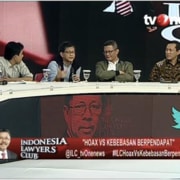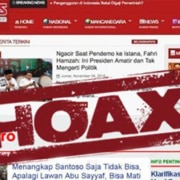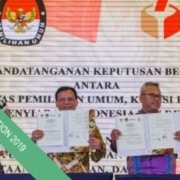
State run TVRI consistently fails to attract more than about 1.5 per cent of the viewing audience. Photo by TVRI.
On election night in 2014, Indonesians tuned in to two 24-hour news stations to see who won. On TVOne, Prabowo Subianto was touted as the winner. Over on MetroTV, Joko “Jokowi” Widodo was declared the winner. Given the partisan coverage of both stations throughout the election, it was not surprising that many viewers had no idea who actually won. Few bothered to check TVRI, Indonesia’s state-run television station.
Since then, citizens have become increasingly wary of partisan mainstream news sites, and are turning to a swathe of alternative online sources of information, some of which are deliberately produced to encourage sectarianism.
One solution to this problem is an independent, fearless, public media that could provide a serious alternative to privately owned conglomerates and the increasing spread of hoax news and disinformation online. Indonesia is in dire need of a robust publicly owned media in the digital era. Unfortunately, public broadcasting in Indonesia is ‘dying’ and needing ‘revitalisation’.
In countries such as the United Kingdom (BBC), Australia (ABC), and Japan (NHK), nation-wide public broadcasters produce news and information across a variety of platforms, including the internet. In Australia, for example, the ABC has three digital television stations, a 24-hour news station that can be live-streamed online, and hundreds of local radio stations (which are also available online), as well as a growing online news and information presence through abc.net.au.
Indonesia’s public media looks more like the United States model, where television station PBS is underfunded and ignored by viewers, overpowered by privately owned cable news stations like Fox and CNN.
Travel to any provincial city in Indonesia and one of the largest buildings will likely be the state-owned TVRI. Many of these buildings are a relic of the expensive infrastructure that went into spreading the propaganda of Suharto’s authoritarian regime. So, for example, in Ambon, 2,000 kilometres from Jakarta, TVRI is a grandiose six-story building on the hill overlooking the city. Yet like most TVRI buildings today, only about half of it is in use, paint is peeling off the walls and some equipment and furniture is about 20 years old.
After the demise of the New Order, Indonesia’s successive governments have largely chosen to ignore TVRI, and the organisation languishes towards irrelevance. TVRI remains full of “organisational problems, ranging from limited resources and a large, mainly unmotivated staff to an extensive, but mainly outdated technical infrastructure”.
TVRI’s annual budget in 2013 was US$74 million. The same year, the average annual budget for a private television company was US$172.8 million. In 2015, disbursement of budget funds to TVRI was delayed, and some staff did not receive salaries for a month.
TVRI contributes little to meeting audience demands for news and information, nor in providing innovative and diverse content for a young generation increasingly glued to mobile phones. In fact, it consistently fails to reach more than 1.5 per cent of audience share.
By contrast to television, however, public radio still plays an important role in Indonesia. Radio Republik Indonesia (RRI), with more than 1,000 radio stations, is the only service by which citizens in many rural communities can access news.
In keeping with trends of convergent multi-platform content delivery of the digital era, RRI and TVRI are scheduled to merge as a single entity by 2019, to become RTRI (Radio and Television of the Republic of Indonesia). RRI employees are concerned this merger will weaken the broadcasters, rather than strengthen them, because they fear a further reduction in funds and job losses.
Indonesia’s state-owned news service, Antara, is also adjusting to digital technologies. In 2016, Jokowi appointed former Jakarta Post chief editor Meidyatama Suryodiningrat to become Antara’s new chief editor. The move signalled some change to the service, but the site still lags behind detik.com and kompas.com in terms of audience share and numbers of journalists.
A merger of Antara, RRI and TVRI to become a multi-platform convergent news service must occur soon, and must be properly funded to compete in news-gathering with other privately owned digital conglomerates. But an injection of funds alone would not be sufficient. An entire rejuvenation of the public broadcasting vision and mission in Indonesia is required.
While TVRI is not the same as it was under the New Order, it continues to be run by managers and editors who see promotion of state-sponsored messages and Pancasila principles as their key purpose. Many Indonesian government officials (and older generation TVRI staff) still see public service news as the mouthpiece of the president.
Indonesia’s public digital media service should not be in the form of Singapore’s digital conglomerate, MediaCorp, nor Malaysia’s Media Prima Berhad, where reports are uncritical of government policies. Citizens must trust their public digital media to have their interests at heart, not that of the government’s. If not, they will continue to turn to alternative sources, especially online. For the most part, in Australia the UK and Japan, citizens trust their public media more than other sources of news and current affairs, even if they too come under attack from private media interests and from their own governments.
Many younger Indonesians have grown up with little fondness for public broadcasting, and are more accustomed to the entertaining television news provided by stations like TVOne and MetroTV, and increasingly, news from social media platforms accessed via mobile phones.
There have been many recent short-term efforts to “counter” hoax news in Indonesia, including verification ticks from the Press Council, anti-hoax units within the palace, even anti-hoax “car free days”. But countering disinformation requires serious long-term initiatives and funds to improve the quality, reliability and reach of Indonesia’s public service media. A credible multi-platform convergent public media would be one way of negating hoax news and misinformation, particularly as the 2019 elections are just around the corner.










